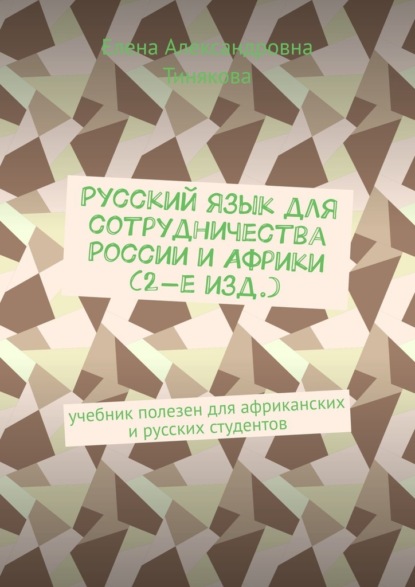
Полная версия:
Русский язык для сотрудничества России и Африки (2-е изд.). Учебник полезен для африканских и русских студентов

Русский язык для сотрудничества России и Африки (2-е изд.)
Учебник полезен для африканских и русских студентов
Елена Александровна Тинякова
© Елена Александровна Тинякова, 2025
ISBN 978-5-0065-4120-7
Создано в интеллектуальной издательской системе Ridero
Международный проект «Глобальная культура-Русский язык для международной коммуникации»
ЗАО «Гуманитарный фонд»
Группа социально-экономического проектирования Санкт-Петербургского союза учёных
НП «Содействие субъектам науки, просвещения, образования»
сектор Народного художественного университета Санкт-Петербурга
Е. А. Тинякова
РУССКИЙ ЯЗЫК ДЛЯ СОТРУДНИЧЕСТВА РОССИИ И АФРИКИ
Учебник
для говорящих на английском языке в Африке
с культурологическим приложением. 2-е изд.. изм. и доп.
Санкт-Петербург
2025
Учебник рекомендован Группой социально-экономического
проектирования Санкт-Петербургского Союза учёных
Учебник «Русский язык для сотрудничества России и Африки»: учебник для говорящих на английском языке в Африке» является частью Международного проекта «Русский как язык международного общения», и составляет единый комплекс с уже изданными учебниками «Новый страноведческий учебник для преподавания английского языка» и «Учебник русского языка для индийцев через посредство английского языка». Проект задуман автором для расширения включения русского языка в международное общение. Прекрасные образцы русской культуры уже давно завоевали глобальный масштаб в межкультурной коммуникации. Русский язык имеет трудно приводимые в закономерность ситуации в фонетике, грамматике и сложно находимые соответствия лексики при переводе, и это тормозит охват стран в его использовании. Иностранным учащимся надо показать, какое ценное культурное пространство держит русский язык. Поэтому учебник имеет обучающую культурологическую часть в дополнение к базовым основам фонетики, лексики и разговора, грамматики, тренирующей логическое восприятие структуры русского языка. Культурологическая информация учебника кратко знакомит с государственными символами России, географией, природой России, этническим разнообразием страны, календарем праздников и памятных дней, русскими учёными, русской литературой, музыкой, живописью, русскими народными танцами и кратко обычаями. Погрузившись в такую захватывающую атмосферу культуры, учащийся поймёт, что нельзя не знать русский язык, и знать его надо хорошо.
Второе издание учебника русского языка для англоязычной Африки изменено по структуре представления русского языка, также дополнен культурологический блок более подробным рассказом о природе России, традициях, народном менталитете. Изучение русского языка африканскими учащимися может быть в диапазоне уровней В1-С1, и при интенсивном обучение до уровня С2. Поскольку культурологическая часть учебника на оригинальном английском языке, русским учащимся изучающим английский язык, она также может быть полезна для общественно-политического и социо-культурного развития на английском языке. Более того в расширенный культурологический блок было внесено много развивающих упражнений, доводящих русских учащихся до уровня С1-С2 по английскому языку. Обучающий материал учебника открывает широкие перспективы преподавателям и студентам изобретать свои развивающие упражнения.
Е.А.Tinyakova
RUSSIAN FOR PARTNERSHIP OF RUSSIA AND AFRICA
Textbook for English speakers in Africa
with a cultural application,2-nd edition, changed and added
Saint-Petersburg2025The textbook is recommended by the Working group
of socio-economic projects of the St. Petersburg Union of Scientists
The textbook «Russian for partnership of Russia and Africa»; for English speakers in Africa» is part of the International project «Russian as a Language of International Communication» and makes a unit with already published textbooks‒ «New textbook of country-studies for learning English» and «Textbook of the Russian language for Indians through the English language». The project was developped by the author to expand the inclusion of the Russian language in international communication. Excellent examples of Russian culture have already won a global scale in intercultural communication. The Russian language has situations in phonetics, grammar that are difficult to bring into correlation with a foreign language and difficult to find lexical matching during translation, and this explains the coverage of countries in its use. Foreign students need to be shown what a valuable culture space the Russian language holds. Therefore, the textbook has a teaching culturological part in addition to the basic foundations of phonetics; vocabulary and conversation, grammar that trains the logical perception of the structure of the Russian language. The culturological information of the textbook briefly introduces Russia’s state symbols, the geography and nature of Russia, the calendar of holidays and memorable days, Russian scientists, Russian literature, music, painting, Russian traditional dancing and customs in brief. Immersed in such an exciting atmosphere of culture, the student will understand that one cannot but know the Russian language, and one must know it well.
The second edition of the textbook «Russian for English-speaking Africa» is changed in structure presenting Russian, also more information about the nature of Russia, Russian traditions and mentality is added. A Russian language textbook is provided for English speakers in Africa, levels B1-C1,C2 is reached by intensive studies. Since the culturological bloc is written in original English, this part of the textbook is useful for Russian students to develop conversational skills on socio-political and socio-cultural topics. The more so as the culturological bloc included many intensive excercises, that may bring Russian learners to Levels C1-C2 in English. The learning material of the textbook is open for teachers and students to invent developing exercises independently.
Оглавление
CONTENTS
1. Why you need to learn Russian
2. Methodical recommendations
3. Types of Russian dictionaries and how to use them
Chapter 1. Entering the Russian language
1.1. Introductory course of phonetics (alphabet, groups
of letters and sounds, syllables to practise distinguishing
sounds; reading rules; about orthoepy, tongue twisters)
1.2. Basic grammar. Morphology: noun, prepositions,
adjective, numerals (counting, dates, time), pronoun,
adverb, verb. Syntax. Punctuation
1.3. Learning to speak in colloquial phrases
1.4. Short thematic texts that will form a dictionary
Chapter 2. Opening Russia
2.1. State symbols
2.2. Briefly about the country of Russia
2.3. Rich nature of Russia……………………………………….
2.4. Public holidays and memorable days in the calendar
of Russia
2.5. Outstanding Russian scientists
2.6. The wealth of the Russian language is its literature
2.7. The world of Russian artists
2.8. Russian classical music
2.9. Russian traditional dances and customs
Chapter 3. Common in the understanding of the world and life
among Russian and English-speaking people (proverbs)
Bibliography
1. Почему
нужно учить русский язык
1. Teaching language
to learners of other languages
(peer-review from a native speaker)
The overall strategy the author encourages and actually employs to teach Russian to speakers of other languages in this text is the Principled Eclecticism. She borrows best practices from the methodologies available and puts them to good use. Among the many techniques available to instructors of teaching language to learners of other languages, are the grammar translation method, the direct method, the audio-lingual method, the Immersion technique, the total physical response, the task based approach, the use of multimedia to enhance the learning experience and the communicative approach. I will endeavour to explain some of these techniques as and when need arises in my interaction with this text.
This text uses a variety of methods and approaches, choosing techniques from each method that she considers effective and apply them according to the learning context and objectives. There is no reliance on one «best method’. This is a plus for this text.
The structure of this text is perfect, language learning/teaching starts with the basics, the vocabulary. The learner is exposed to the preliminaries – the sounds (the presentation of the phonetics of the Russian language sets the goal to reduce the foreign accent to minimum when pronouncing Russian words and phrases), the words and phrases, but what is more, these words are placed in the context of the cultural space – the poems/songs at the start of the book are obligatory a necessary addition. How I wished these songs were given their English equivalents, this would have helped the learners more.
The author could have had her own reasons for leaving out the English print. The provision of Dictionaries at this stage could have been one such good reason. Translation though, is an option too early at this stage, but there is no harm in coming back to these texts, over and over again as the learner gains mastery of the language. The breaking down of teaching units into cultural thematic areas is another strategy the author uses to help with the translation. In terms of methodological application, called upon to bear here is the total immersion strategy (and of course the communicative approach suggested in the Immersion technique). As the name suggests, this is a situation where the learner is immersed in the milieu of the target language as well its culture. The learner is expected to operate in the target language at all times. This is a difficult feat to achieve, unless in a situation where the target language is also the language of instruction in the entire school system.
Aspects of the Audio lingua Method are called to bear in the early stages of the book. This methodology emphasises the use of repetition and therefore habit formation. During these early encounters with the language aspects of repetition to form habits is encouraged. It is important to memorise Russian sentences and phrases… which are supported by understanding in English. Comparison of Russian and English texts will definitely contribute to the expansion of the vocabulary for communication in Russian.
It is worth mentioning another positive characteristics to this text. The author includes all sorts of dictionaries, all to the advantage of the learner. We have among the dictionaries given the explanatory dictionary of the Russian language, dictionaries of synonyms as well as antonyms, the dictionary of phraseological units, the terminological dictionaries, which are in sections such as medical, technical etc. Learning how to use a dictionary is a good starting point to language mastery.
As they say, speaking a bit of the language of the country you are visiting is always a good idea. Locals will appreciate the effort and will respond positively. This text provides the language to use in various practical situations; these include the home situation where for example all the expected activities around the home are covered – from breakfast through to dinner. In between family time, the parents with the children at the play, in the garden – all aspects are covered and in such detail.
The dialogues suggested are phenomenon in their coverage, given both in Russian and in English with such details. Also given in both Russian and English is language as you would need to use at the Railway station, at the Airport and the shop… The learner is never left stranded in whatever situation they find themselves. That is how thorough the book is.
Having ploughed through the text, the course, and now armed with an appreciable knowledge of the Russian language, the learner is given interesting questions in English, but they are expected to answer them in Russian. The author here uses aspects of the communicative approach. This approach is in a way a culmination of the foregoing methods. In this approach focus is on learner ability to communicate various functions, such as asking and answering stated questions, making requests, describing certain actions, narrating given situations and making comparisons. The communicative approach is achieved through task assignment and problem solving – the two key components of critical thinking. The strength of this approach is that learning happens in a context. Grammar is not taught in isolation, but in practical situations. Error correction is not emphasised (and this removes anxiety from the learner), as the understanding is that learners will naturally achieve accuracy through frequent use of, and communicating in the language rather than analysing it.
Teach culture alongside the language. This is strength of this text. Teaching communication is not enough in itself, exposure to the culture from which the language springs, will help the learners not just appreciate the real meaning of the words they are learning, but learn the language with relative ease. The inclusion of the proverbs and sayings of the wise, and its comparison to counterpart proverbs and sayings of the wise in important English speaking countries – Britain and America is highly appreciated. This is the culturological strategy the author recommends. The textbook combines Russian language teaching and intensive acquaintance with the Russian culture.
This book, therefore, positions the teaching of the language in the firm foundation of its context – the Russian culture. With this comes all the beauty of Russia as a country, its beautiful landscape, its colour, its rivers and lakes, its beautiful people, its names, its animals, its beautiful Arts – music, paintings, its folklore and literature, its science and scientists, its seasons etc. The author sums it all when she says: «Immersed in such an exciting atmosphere of culture, the student will understand that one cannot but know the Russian language, and one must know it well».
The learner has no choice but to learn the language for the benefits are immense!
What more can one say, this is a bumper harvest for all you who would want to delve into the teaching of Russian as an international language, and you definitely cannot go wrong.
Enjoy it. Kanyampa Manda19/11/2020.
REFERENCES:
Baylis, P. (2007). Current Approach to Language Teaching and Learning. UWS, Bankstown, NSW, Avstralia.
Bowen, J. D., Madsen, H., & Hilferty, A. (1985). Where we’ve been: insights from the past. InTESOL: Techniques and procedures (pp. 3—30). Boston: Heinle & Heinle.This text provides an informative summary of past language teaching approaches.
Celce-Murcia, M. (2001) Language teaching approaches: An overview. InTeaching English as a second or foreign language (3rd ed., pp. 1—11).Boston: Heinle & Heinle. This text provides an overview of past language teaching approaches with bulleted lists of their main points.
David Nunan, 1991), Language teaching methodology:
a text book for teachers (the Prentice Hall International.
Larsen-Freeman, D. (2000).Techniques and principlesinlanguage teaching (2nd ed.). Oxford, England: Oxford University Press. This volume provides a discussion of the direct method including a sample lesson followed by an analysis of the principles of the method.
Richards, J. C. (2005). Communicative language teaching today. Singapore: RELC,1—44.
Kanyampa Manda. (Рис.1)
BA. English and History-University of Zambia, Honours BA – University of South Africa, MA Literature and languages-Solusi University Zimbabwe.
Teacher: English Language and Literature, Chief Examiner School certificate Literature in English-Zambia.
Author: ReCreation, an anthology of poetry and short fiction – ISBN: 978-7283-8416-0 (sc) /ISBN: 978-1-7283-8420-7 (e) AuthorHouse (Trade mark) UK.
Рисунок 1
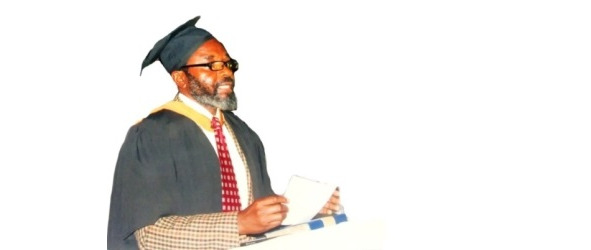
Task: Discuss the per-review with students (before studying by the textbook and after completing its study)
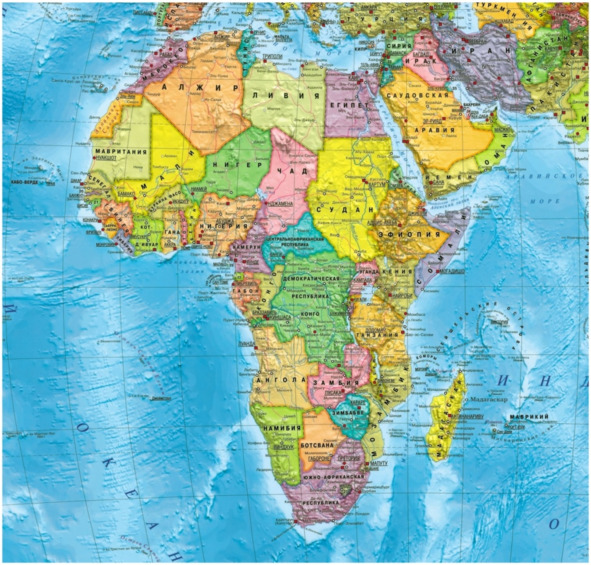
Рисунок 2
History of Africa opened out across our planet
Africa is the largest continent in terms of territory and population (Рис.2). In 2023, it remains one of the most multinational, where representatives of numerous nationalities and ethnic groups live. According to the International Law, there are 54 recognized independent States in Africa. This is the largest number of countries, on the level of state formation, among all the continents.
Africa is striking in its versatility. These are cultural attractions, historical heritage, and natural corners that attract tourists from all over the world.
Africa has gone through a hard period of colonization. The first colonies in Africa were established by the Portuguese in the 16 century. The largest of them were Angola and Mozambique, which had a great potential of natural resources. Great Britain (18 colonies) and France (16) had the largest possessions, but Germany, Spain, Italy, Belgium and Portugal also had colonies.
The process of decolonization of Africa began actively after the Second World War. The Year of Africa – the year of liberation of the largest number of colonies – was declared 1960.
On May 25, Africa celebrates African Liberation Day every year, also known as African Unity Day. (Рис.3)
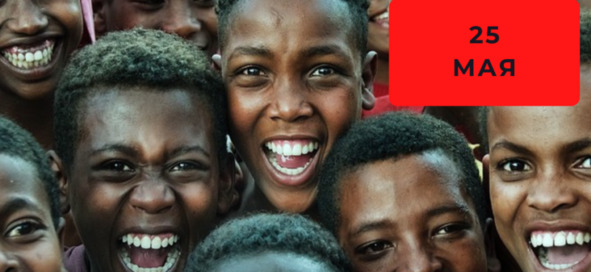
Рисунок 3
The Day of the Liberation of Africa was established in 1963 on the basis of the decision of the Organization of African Unity, which united African countries in the struggle for independence.
Task: Write an essay «Africa today» (1,5—2 p.)
Oral group discussion «Africa for collaboration with Russia» (look the information below)
Россия имеет три крупных проекта российских компаний в Анголе, Гвинее и Египте, а также образованы советы для успешной работы российского бизнеса в Африке.
Russia has three major projects of Russian companies in Angola, Guinea and Egypt, as well as consulting centers for the successful operation of Russian business in Africa.
Деятельность российских промышленных компаний в Африке осуществляется примерно по 100 направлениям; (Рис.4) их можно классифицировать на пять групп:
– работающие промышленные предприятия, созданные на основе отечественных проектных решений и с использованием отечественного оборудования, в основном в сырьевом, энергетическом и телекоммуникационном секторах;
– строящиеся промышленные объекты с российскими технологиями (например, металлургический Ajaokuta Steel
– в Нигерии, «Российская промышленная зона» в Египте, центр ядерной науки и технологий в Замбии, «Уралхим» с ангольской Grupo Opaia строит завод «Аммиак-карбамид»);
– поставки несырьевой, непродовольственной российской промышленной продукции;
– научно-инжиниринговые услуги (экспертизы, аудит, предварительное и текущие технико-экономические обоснования, испытания, разработки технических проектов и технологических регламентов, обоснование техники безопасности и пр.;
– покупка готовых предприятий.
The activities of Russian industrial companies in Africa are carried out in about 100 areas; they can be classified into five groups:
– operating industrial enterprises created on the basis of domestic design solutions and using domestic equipment, mainly in the raw materials, energy and telecommunications sectors;
– industrial facilities under construction with Russian technologies (for example, the metallurgical Ajaokuta Steel in Nigeria, the Russian Industrial Zone in Egypt, the center of nuclear science and technology in Zambia, «Uralchem» with the Angolan Grupo Opaia is building the Ammonia-Urea plant);
– delivery of non-primary, non-food Russian industrial products;
– scientific and engineering services (expertise, audit, preliminary and current feasibility studies, tests, development of technical projects and technological regulations, safety justification, etc.;
– purchase of ready-made enterprises.
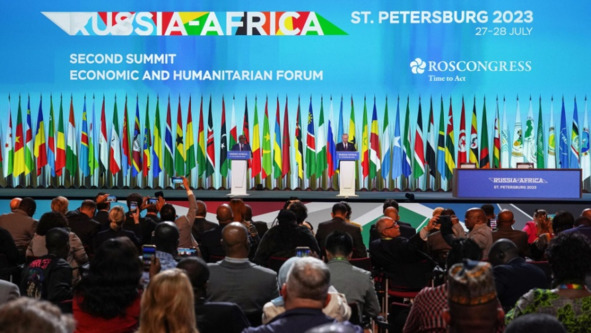
Рисунок 4
Русская духовность в Африке
Russian spirituality in Africa
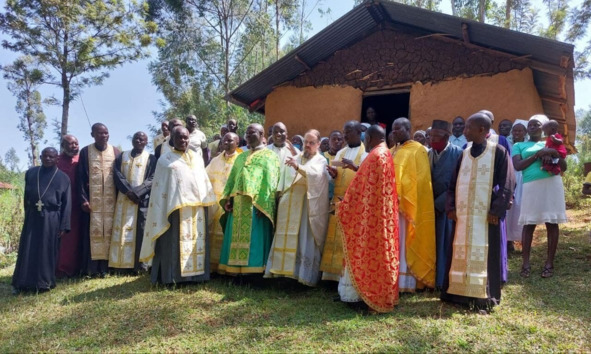
Рисунок 5
Африка – это 1,3 млрд человек населения и 54 страны, неравнодушные к православной вере. (Рис.5).
Экзархат в Африке – Православная церковь.
В декабре 2021 года в Африке открылся Экзархат РПЦ.
Теперь же Русская Церковь ведёт проповедь по всей Африке, где сейчас от 1 до 3 миллионов православных.
В африканских странах растет количество приходов Русской православной церкви. Рядом с храмами строятся школы, детсады, гуманитарные центры.
Africa is 1,3 billion people and 54 countries that are not indifferent to the Orthodox faith.
Exarchate in Africa – Russian Orthodox Church.
In December 2021, the Exarchate of the Russian Orthodox Church opened in Africa.
Now the Russian Church is preaching throughout Africa, where there are now from 1 to 3 million Orthodox.
In African countries, the number of parishes of the Russian Orthodox Church is growing. Schools, kindergartens, humanitarian centers are being built near the temples.
На Втором саммите «Россия-Африка» в Санкт-Петербурге 27 июля 2023 года Святейший Патриарх Московский
и всея Руси рассказал: «Вместе с тем, присутствие Русской Православной Церкви на территории Африки не какая-то беспрецедентная новация. Русские приходы начали появляться на континенте еще в XIX – начале XX века… в Абиссинии в 1889 и 1896 годах были построены русские храмы, а постоянный приход Русской Православной Церкви в Египте был создан в 1914 году. После революции в России… приходов в Африке стало открываться все больше: в 1920 году был освящен храм в Тунисе, в 1922 году был создан приход в Алжире, в 1927 году – открыты русские православные приходы на территории Марокко. В 1998 году мне довелось освящать первый русский храм
в Южно-Африканской Республике».
At the Second Russia-Africa Summit in St. Petersburg on July 27, 2023, His Holiness Patriarch of Moscow and All Russia said: «At the same time, the presence of the Russian Orthodox Church in Africa is not some unprecedented innovation. Russian parishes began to appear on the continent back in the 19th – early 20th centuries… in Abyssinia, Russian churches were built in 1889 and 1896, and the permanent parish of the Russian Orthodox Church in Egypt was created in 1914. After the revolution in Russia… more and more parishes began to open in Africa: in 1920 a temple was consecrated in Tunisia, in 1922 a parish was created in Algeria, in 1927 Russian Orthodox parishes were opened in Morocco. In 1998, I had a chance to consecrate the first Russian church in the Republic of South Africa».
Русская православная церковь расширяет присутствие на африканском континенте. Ее миссионеры уже охватили 23 страны, в которых служат более 200 клириков, подчиняющихся РПЦ.
Патриарший экзархат Африки начал 2024 год с самого масштабного выезда священнослужителей Русской православной церкви в разные страны африканского континента.
The Russian Orthodox Church is expanding its presence on the African continent. Her missionaries have already covered 23 countries in which more than 200 clerics subordinate to the Russian Orthodox Church serve.



